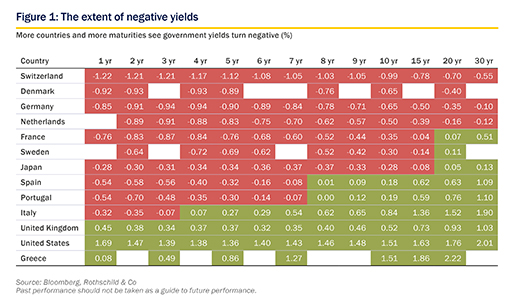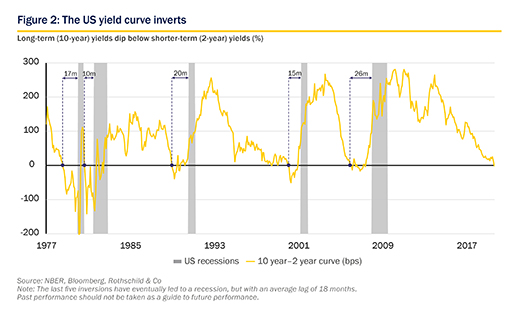Market Perspective – Bondstock

Kevin Gardiner, Global Investment Strategist, Wealth Management
Bond markets' summer of love
Bonds were already performing strongly, but gathered momentum from May. Many European government yields have recently hit new all-time lows - below even those seen in 2016. Negative yields have spread across more countries and maturities (figure 1), to almost one-third of high-quality global bonds, compared with one-quarter in 2016. Germany has raised 30-year funds at a negative yield. Greece's government faces almost the same terms as Uncle Sam.
Click the image to enlarge
The short-term interest rates priced into money markets have also been falling as the big central banks have followed the lead from bonds. After encouraging markets to expect lower policy rates, the Federal Reserve (Fed) duly delivered a cut - the first in a decade - at the end of July. At least one more cut seems likely soon. Rather than “taking the punch bowl away”, then, Powell's Fed has offered Bondstock another round of drinks. The European Central Bank also seems poised to loosen, and the Bank of England might have signalled similarly - particularly with that Brexit risk - if the pound had not been doing some of its work for it
Policy rates have nonetheless lagged the bond markets, and the yield curve - the gap between long-term and shorter-term yields - has inverted along more of its length, a traditional sign of looming recession (figure 2).
Click the image to enlarge
Why have bonds been partying?
We wrote about bonds in early July, but the summer surge warrants a revisit. Why the festival mood?
The possible explanations we focused on then were (1), a looming economic accident, and (2), more contentiously, a fall in inflation independently of economic growth. For completeness, we might add (3), altered time preference and/or (4), a technical squeeze.
1. Looming downturn
The idea that bonds can see a big economic downturn, which will reduce inflation and policy rates, is the popular prime suspect. The market is credited with near-mystical forecasting ability. Our fixed income specialist Rob Stewart notes that media use of the word “recession” has surged to levels not seen since 2009.
But data point to slowdown, not dramatic recession. Risks are focused on manufacturing, hit by tariffs and a perfect storm in the auto sector (especially in Germany and China), and the UK, with a Brexit-related inventory cycle. Service sectors and labour markets are stronger, and the key US economy seems to be slowing least.
Nor do we buy the idea that recessions these days are necessarily more dangerous, and/or that the authorities have no levers left to pull. This has been a well-behaved cycle, and fiscal policy has plenty of room for manoeuvre.
True, the yield curve has usually inverted before recessions - but with such varying lags as to be of little practical use. US stocks have on average risen for a year afterwards. We think bonds' fabled forecasting reputation is unwarranted. The future is profoundly unknowable - to all of us.
2. Secular deflation
This possibility is overlooked, but intriguing: it would be a free lunch for most assets.
A change in the way economies work - with supply driving growth, rather than demand - could see inflation not just stay subdued, but falling further and even turning negative, even alongside ongoing, profitable growth.
As noted in July, this seems to have happened before in the US and UK in the second half of the 19th century (and to some extent in Ireland since the early 1990s: the Celtic Tiger is still misunderstood).
Possible reasons for the end of the 'Phillips curve', linking growth positively to inflation, might include liberalised global labour markets and new technology. But globalisation is not exactly flavour of the month, so why seize on this now?
The inflation expectations priced into government bonds do seem to have led nominal yields lower. But core or real yields - net of that expected inflation - have also fallen, though they are not as historically low as nominal yields.
3. Altered time preference, storage cost
Academic writing on interest rates is not much fun - those Austrian economists are obscure for a reason. But interest rates ultimately reflect our collective view of the future (our 'time preference') and the physical terms at which we can exchange today's consumption today for tomorrow's (the 'production frontier').
Because we usually see the future as uncertain, we expect a reward for deferring spending - and because the value of what we make is usually bigger than the value of the stuff we use in making it, productive enterprise has been able to deliver that reward. Positive interest rates have discounted the uncertain future and value-adding production processes.
Both could change. In volatile times, people might not need a reward for waiting, and may even value future consumption more highly than today's. And productive resources can certainly be employed so badly that they destroy value (see any planned economy, for example).
Another rethink might focus on storage costs. With tangible assets - such as property, collectibles and gold bars - we expect to pay for storage and security. So why not for digital assets? Arguably, in the post-Global Financial Crisis, cyber-threatened world, security costs have risen. Might negative interest rates partly reflect the revealed cost of the financial infrastructure?
Unlike vanishing inflation, these explanations might be bad news for future (real) returns across most investment assets, almost by definition.
In our view, however, today's many challenges do not yet justify reversed time preference. Corporate assets still suggest a value-adding production frontier (indeed, the gap between US return on equity and a risk-adjusted 10-year Treasury yield recently hit an all-time high). And storage costs are likely to remain de minimis.
4. A technical market squeeze
“More buyers than sellers” was JP Morgan's fabled reply to being asked why the stock market had risen one day. Perhaps fancy theories have been less important in boosting bonds than circumstance and coincidence?
Quantitative easing has left central banks holding a lot of bonds. Meanwhile, many pension plans and life assurers are compelled to buy bonds simply because they seem to offer a predictable way of matching future liabilities. Risk-parity and trend-following strategies may have further added to non-economic demand. At the same time, governments - the US's aside - have largely been well-behaved, keeping a lid on supply. With a small free float and many non-economic buyers, a thin market may have been squeezed higher. This is hardly profound - the 'narrative fallacy' strikes again - but that doesn't mean it must soon reverse, or affect other assets.
Winter of discontent?
This lengthy expansion faces clear and visible risks: explanation (1) has clearly been playing a material role. We have sympathy for (2), if only because it might shake a complacent economics establishment out of a lazy Keynesian worldview, but the timing doesn't ring true. We have less sympathy for (3). But explanation (4) for us carries most weight.
On this view, we surely have to stay alert for recessionary risks, but bonds are not necessarily telling us anything new. Unless or until the data worsen more materially, we can't see an investment case for most bonds.
Meanwhile, stocks, though volatile, also had a better summer than we'd expected. Economic risk has so far been offset by those lower policy rates, perhaps. This may not last - that more serious economic downturn might arrive, or a post-festival hangover in the money markets may give stocks a headache too. But while neither of the two big markets seem to have much tactical headroom, stocks remain most likely to deliver inflation-beating returns in the longer term.
Click here to continue: Market Perspective: UK consumers: ready for Brexit?
In this Market Perspective:
- Foreword
- Bondstock (current page)
- UK consumers: ready for Brexit?
- Economy and markets: background
- Important information
Download the full Market Perspective in PDF format (PDF 704 KB)

